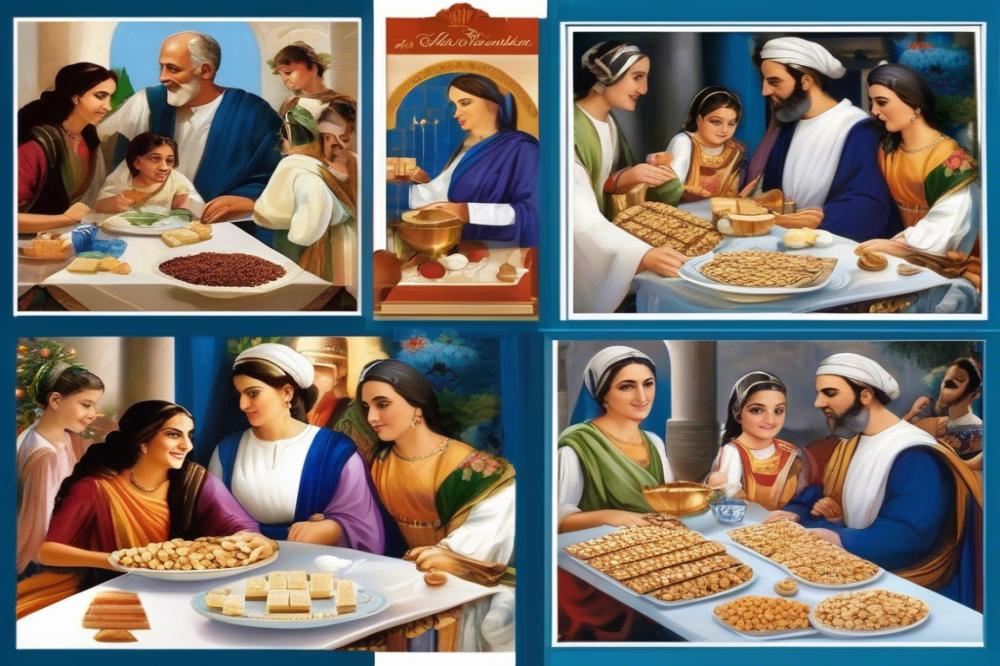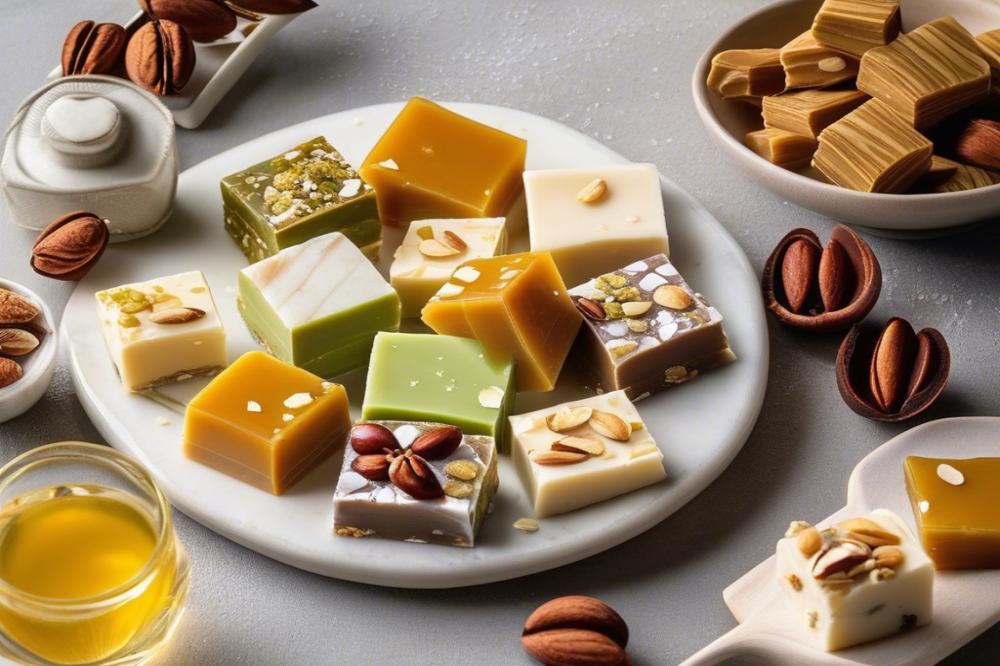Introduction
Mandolato is a traditional Greek sweet that holds a special place in the hearts of many. This chewy candy, often made with a combination of honey, sugar, and nuts, is more than just a dessert; it represents a cherished cultural heritage. Throughout Greece, different regions add their own twists, creating variations that celebrate local flavors.
The significance of Mandolato goes beyond taste. In Greek culture, sweets often accompany celebrations and holidays. During festive seasons, families gather to make homemade nougat as a way to bond and share joy. Recipes may vary, but the essence remains the same: a delicious reminder of tradition.
Nougat, as a concept, is not limited to Greek cuisine. Many cultures have their own versions, often made with almonds or pistachios. These variations include almond nougat and pistachio nougat, which are popular choices in many households. Whether enjoyed as a simple treat or as a grand dessert during special occasions, nougat is a staple in the world of traditional sweets. Celebrated for its delightful texture and rich flavor, this confection has become synonymous with holiday treats and festive recipes. Each bite is a testament to the craft of making Greek nougat, inviting everyone to enjoy a taste of history.
What is Mandolato?

Mandolato is a type of Greek nougat made with a blend of nuts, honey, and sugar. This chewy candy is popular during the holiday season, often enjoyed as part of festive recipes. Its roots trace back centuries, intertwining with the rich culinary traditions of Greece. Greek desserts, with their variety and depth, have a special place for this sweet treat.
As a traditional sweet, mandolato finds kinship with other nut-based confections. Unlike almond nougat, which tends to be crisp and sometimes hard, this Greek version has a softer, chewier texture. Many choose to incorporate various nuts, which can include almonds, pistachios, or even walnuts. Each nut brings its flavor, creating delightful variations on the basic nougat recipe.
Pistachio nougat, on the other hand, has its own unique characteristics. Generally, it showcases the earthy sweetness of pistachios, making it a favorite among many. While similar in concept, mandolato emphasizes a blend of flavors, uniting different nuts harmoniously. This fusion results in a dessert that many find irresistible.
When considering its place in Greek culture, mandolato stands out during festive gatherings. Families often prepare homemade nougat to share with loved ones. This practice connects generations, as recipes are passed down through time. Its popularity remains strong, especially during holidays, where it serves as both a treat and a symbol of hospitality.
In summary, mandolato is more than just another sweet. It reflects the artistry of Greek cuisine. This nougat bridges the gap between tradition and taste, making it an essential part of the dessert landscape in Greece.
Ingredients List and Measurements

To create this delightful nougat recipe, you will need the following ingredients:
- Almonds: 200 grams
- Pistachios: 100 grams
- Sugar: 250 grams
- Honey: 150 grams
- Egg whites: 2
- Vanilla extract: 1 teaspoon
- Salt: a pinch
Each ingredient brings its own nutritional qualities. Here’s a breakdown of the nutritional content per serving.
- Almonds (200 grams): Approximately 1160 calories, 100g fats, 40g protein, 40g carbohydrates.
- Pistachios (100 grams): About 562 calories, 45g fat, 20g protein, 28g carbohydrates.
- Sugar (250 grams): Around 960 calories, 0g fat, 0g protein, 250g carbohydrates.
- Honey (150 grams): Roughly 450 calories, 0g fat, 0g protein, 135g carbohydrates.
- Egg whites (2): Nearly 34 calories, 0g fats, 7g protein, 0g carbohydrates.
- Vanilla extract (1 teaspoon): Contains about 12 calories, negligible fats, and carbs.
- Salt (a pinch): Adds no significant calories or macronutrients.
Nuts play a vital role in this traditional sweet. Almonds and pistachios both offer significant health benefits. They are rich in healthy fats, proteins, and fibers. These nutrients can support heart health and help in maintaining good cholesterol levels. The protein content is especially beneficial, providing energy and muscle support.
Considering the total sugar in this homemade nougat, moderation remains key. The combo of sugar and honey gives it that classic chewy texture, which is perfect for a festive treat. You can’t overlook the role of egg whites, either. They help create a light and airy structure in the nougat, making it soft yet satisfying to munch on.
This recipe not only brings together flavor but also a variety of textures. Almond nougat and pistachio nougat are both delicious. Swapping ingredients can lead to unique variations like adding walnuts or hazelnuts. Experimenting with different combinations can pave the way for innovative holiday treats. Whether it’s for a family gathering or just a personal delight, creating this dessert can be both enjoyable and fulfilling.
Cooking Instructions

Creating your own homemade nougat is easier than you might think. Follow these step-by-step instructions to make delicious Greek desserts filled with nuts. Each step is crucial for achieving that perfect chewy texture.
1. Prepare the nuts by roasting and chopping.
Start by selecting your choice of nuts. Traditional options include almonds and pistachios. Roast them lightly in the oven to enhance their flavor. After they cool, chop them into smaller pieces. This adds a delightful crunch to the candies.
2. Cook sugar and honey to the right temperature.
In a heavy-bottomed saucepan, combine sugar and honey. Heat the mixture over medium flame. A candy thermometer is your best friend here. Aim for a temperature of about 150°C (300°F), known as the hard crack stage. This is essential for that perfect nougat texture.
3. Whisk egg whites until stiff peaks form.
While your sugar mixture is heating, begin whisking egg whites in a separate bowl. Use a clean mixer for the best results. Whip until stiff peaks form; this process adds volume and lightness to your nougat. When the sugar reaches the right temperature, carefully pour it into the egg whites.
4. Mix all ingredients together and spread into a mold.
Once the sugar syrup is combined with the whipped egg whites, quickly fold in your roasted nuts. Make sure to do this swiftly to avoid hardening. Utilize a greased mold for pouring the mixture. Gently spread it evenly within the mold to achieve a consistent thickness.
5. Allow to set and cut into pieces.
After spreading the mixture, let it set at room temperature. This may take several hours or overnight. Once it has firmed up, carefully remove it from the mold. Use a sharp knife to cut into bite-sized pieces.
For an even more delightful experience, consider dusting the pieces with powdered sugar or cornstarch to prevent sticking. Always check the temperature of your sugar closely. Burning the sugar is a common mistake that can ruin your batch.
Pay attention to how long you whip the egg whites. Too little time leads to insufficient volume, while over-whipping can lead to a grainy texture. If you’re preparing almond or pistachio nougat, the type of nut you choose will also affect the final taste and texture.
Homemade candy can be a fun project, especially around the holidays. Whether you’re sharing festive recipes with family or enjoying these traditional sweets yourself, follow these tips for the best results.
Serving Suggestions and Storage

When it comes to holiday treats, few things can match the delightful taste of homemade nougat. This chewy candy serves well as a festive recipe during gatherings. Cut into bite-sized squares, it can be placed on a decorative platter alongside other traditional sweets. Friends and family will appreciate a mix of flavors, especially when almond nougat and pistachio nougat are included. Different nuts add varying textures, making every bite interesting.
Consider pairing this Greek dessert with warm beverages. A cup of spiced tea or rich coffee complements the sweetness of the nougat. Alternatively, a glass of dessert wine can enhance the flavors beautifully. Not only does this duo offer balance, but it also elevates the overall experience of enjoying your holiday treats.
Storage is just as important as serving. Keeping the nougat fresh requires careful handling. Wrap pieces tightly in wax paper or plastic wrap to maintain their ideal texture. Storing them in an airtight container prevents moisture from ruining the candy. A cool, dry location is best for storage, allowing the nougat to stay flavorful and chewy for weeks.
For those wanting something extra, consider assembling gift boxes. Fill small boxes with pieces of nougat and other Greek desserts. Personal touches like a handwritten note can make these gifts even more special. Overall, serving and storing this delightful treat can create lasting memories during the holiday season.
Cultural Significance of Mandolato
One cannot discuss Greek celebrations without mentioning the role of traditional sweets like Mandolato. This nougat recipe is often found in homes during festive times. Many families associate this chewy candy with love and sharing. Family gatherings, particularly during holidays, become incomplete without this delightful treat.
Almond nougat and pistachio nougat are beloved variants. They showcase the rich flavors of nuts that are crucial to Greek desserts. Each bite reveals a story of its origins. During significant events, this homemade nougat is a symbol of hospitality. Guests feel welcomed with a plate of these sweet cubes, often handmade with care.
Celebrations like Christmas and Easter see an increase in the crafting of holiday treats. Preparing these festive recipes becomes a cherished family tradition, passed through generations. Children eagerly learn how to make Mandolato, ensuring they carry on this culinary heritage. The process transforms into a bonding experience, as many hands come together in the kitchen.
In Greece, sweets reflect the culture’s depth. From local ingredients to cherished recipes, each dessert tells a tale. This is why many families dedicate time to make their own nougat rather than buying it from stores. Homemade versions boast freshness and love that cannot be replicated.
During festive seasons, the presence of Mandolato brings joy and nostalgia. It embodies the essence of sharing and celebration. Greek culture highly values these rituals. They reinforce family connections while honoring traditions that have intertwined with the community’s identity.
Wrapping Up the Tradition of Greek Nougat
The significance of this classic sweet in Greek culture cannot be overstated. For many, it represents more than just a treat; it embodies cherished memories of family gatherings and celebrations.
Making nougat at home can be a deeply rewarding experience. The process allows for creativity and connection. Mixing the sweet syrup with nuts opens up a world of flavors and textures. Moreover, it’s a wonderful opportunity to share something special with loved ones. There is pure joy in giving homemade sweets, especially when they reflect a rich heritage.
As you embark on this journey, consider trying this nougat recipe in your kitchen. The satisfaction derived from creating something delicious, and the warmth of sharing it, are truly unmatched. Every bite of your creation will spark stories and delight those who taste it.
In conclusion, taking the time to make this traditional Greek confection can enhance your culinary skills and bring happiness to your table. So, gather your ingredients, invite your family into the kitchen, and embrace the joy of crafting this beloved sweet. You might find that the experience is just as satisfying as the final product.



